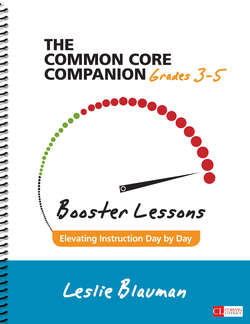Читать книгу The Common Core Companion: Booster Lessons, Grades 3-5 - Leslie Blauman - Страница 10
На сайте Литреса книга снята с продажи.
Think Core Practices
ОглавлениеAs Kelly Gallagher (2015) points out in his book In the Best Interests of Students, “Remember that good teaching is not about ‘covering’ a new list of standards; good teaching is grounded in practices proven to sharpen our students’ literacy skills” (p. 3). The spirit of this book is just that: I want to help you center your instruction on what we know works in developing learners’ capacity to read, write, listen, and speak. To that end, the Big Ticket practice at work is connecting reading and writing. A reading lesson is followed by a companion writing lesson, or vice versa, so that students benefit from seeing the yin and yang of these two processes. A mountain of research supports instruction that helps students see both reading and writing as reciprocal processes. When we teach students to read like writers and write like readers, each endeavor makes much more sense to kids.
In addition, the lessons and learning integrate select core practices. These are the research-based practices that have proven to be worthwhile. So for each lesson sequence, I’ve handpicked the core literacy practices most relevant to the lessons and learning. What follows is the master list of them (go to www.corwin.com/thecommoncorecompanion to find definitions of each one).
Sequence 1 includes
Gradual release model
Co-construct
Turn and talk
Graphic organizers
Reflection
Explicit teaching
Responsive teaching
Student ownership
Anchor charts
Metacognition
Tying content to real-world examples
Sequence 2 introduces
Modeling
Scaffolding
Annotating texts
Using text evidence
Process writing
Highlighting
Annotating texts
Using text evidence
Rubrics
Feedback
Sequence 3 includes
Turn and talk
Mentor texts
Mini-lessons
Independent reading
Reading journals
Conferring
Feedback
Coaching
Process writing
Independent writing
Book clubs
Anchor texts
Student ownership
Independent reading
Revisiting texts
Connecting across the curriculum
Sequence 4 introduces
Mentor texts
Mini-lessons
Modeling
Peer work
Anchor charts
Annotating texts
Graphic organizers
Scaffolding
Rubrics
Sequence 5 includes
Guided practice
Co-construct
Mentor texts
Modeling
Graphic organizers
Using text evidence
Revisiting texts
Peer work
I decided not to take the time in this book to call on the carpet practices that don’t have much evidence to support them, but I encourage you to do a makeover of your reading and writing block and consider retiring practices that seem, well, tired. By tired, I mean they don’t really move the needle on students’ skills or engagement or carry weight in terms of helping you to know your readers and writers. Rewards-driven reading routines, for example, are a no-no. Worksheets and word searches are two other common time zappers. See Debbie Miller and Barbara Moss’s No More Independent Reading without Support for more insights on ineffective and effective reading practices. For writing, some common ways in which writing is shortchanged in schools include not allowing for student choice or only writing to prompts, jumping from activity to activity without a focus or focusing instruction only on the mechanics, or writing classes that don’t address the workshop model, which allows for a focus lesson, independent work, and a closure (Fletcher and Portalupi 2001; Gallagher 2011; Graves 1994; Ray 2001; Routman 2005). These are writing routines that have no research support.
Students need to be writing across the curricula, and often. Reading is often described as the invisible process that therefore needs lots of think alouds and teacher demonstrations to make it “visible,” but I would argue that a writer’s process needs an equal amount of modeling.
What’s the through line of the core practices that do work? I’d say it’s authenticity. Yep, that’s another term used so often it loses meaning, so I’ll define it for myself and for this book as meaning being respectful of students’ maturity. Children don’t need or want cutesy, and their nose for busywork is sharper than a hound dog’s. Be authentic with them instead. They want to feel they are in the same reading club and the same writing club as you are. So as you will see in these lessons, share the books and other texts that you truly adore. Share the op-eds, reviews, sports stories, news that irritated you, or inspired you—and they will follow suit. Share pieces of writing you’ve received or done that have something to teach them. Tell them about what’s hard or easy for you as a writer. Ask them for permission when you want to share what they have written with others. This last point leads into the third facet of integration that drives this book: peer models.
